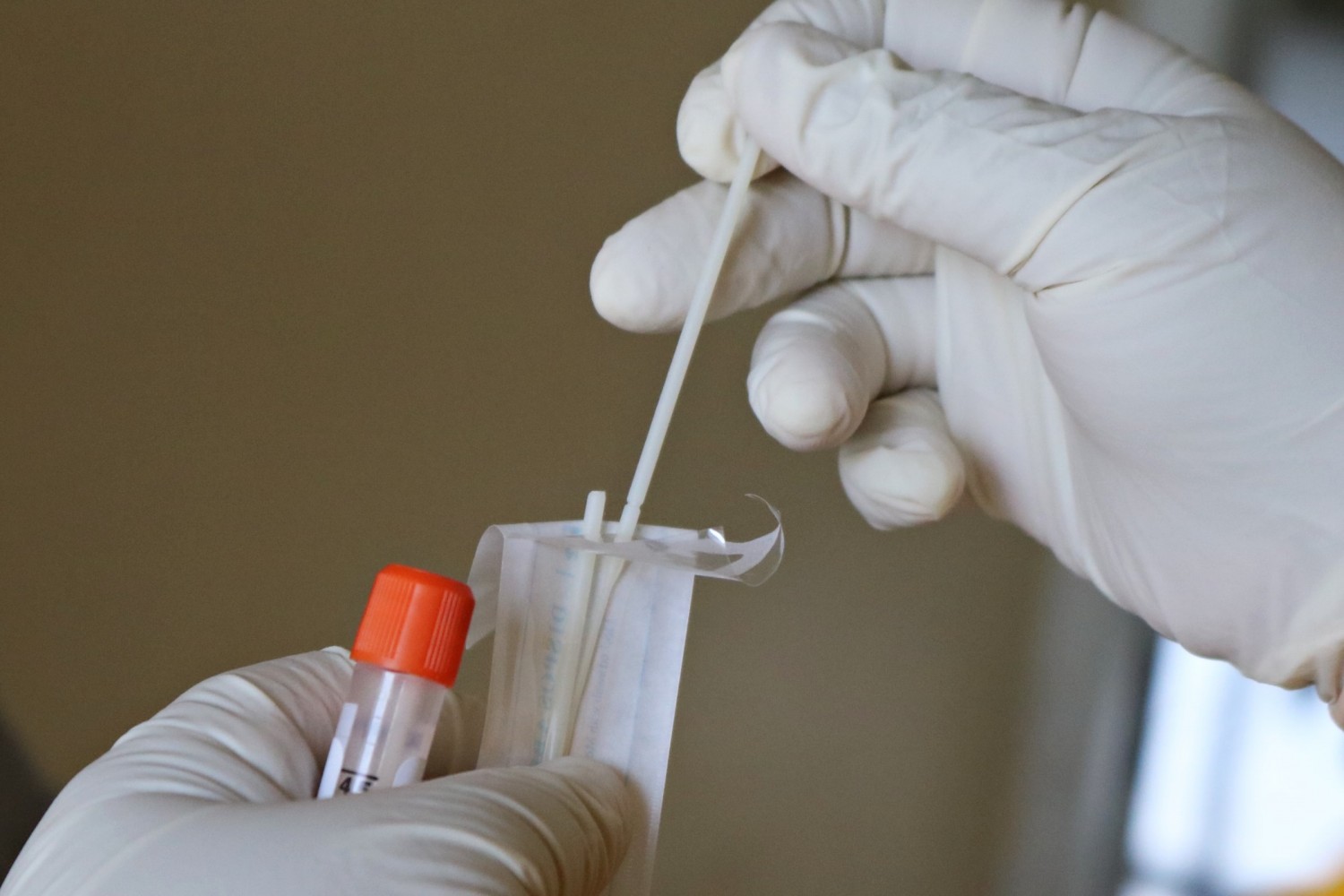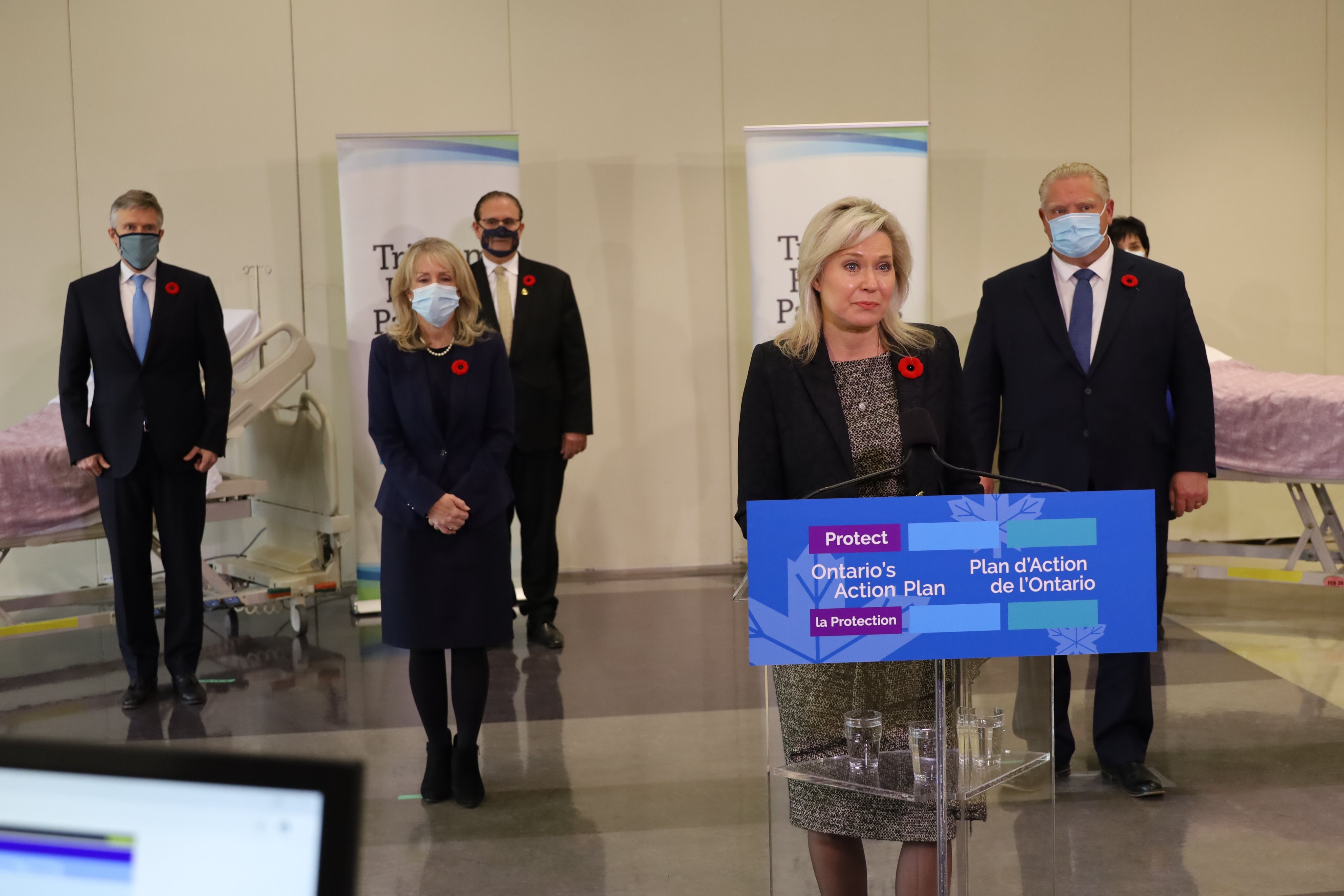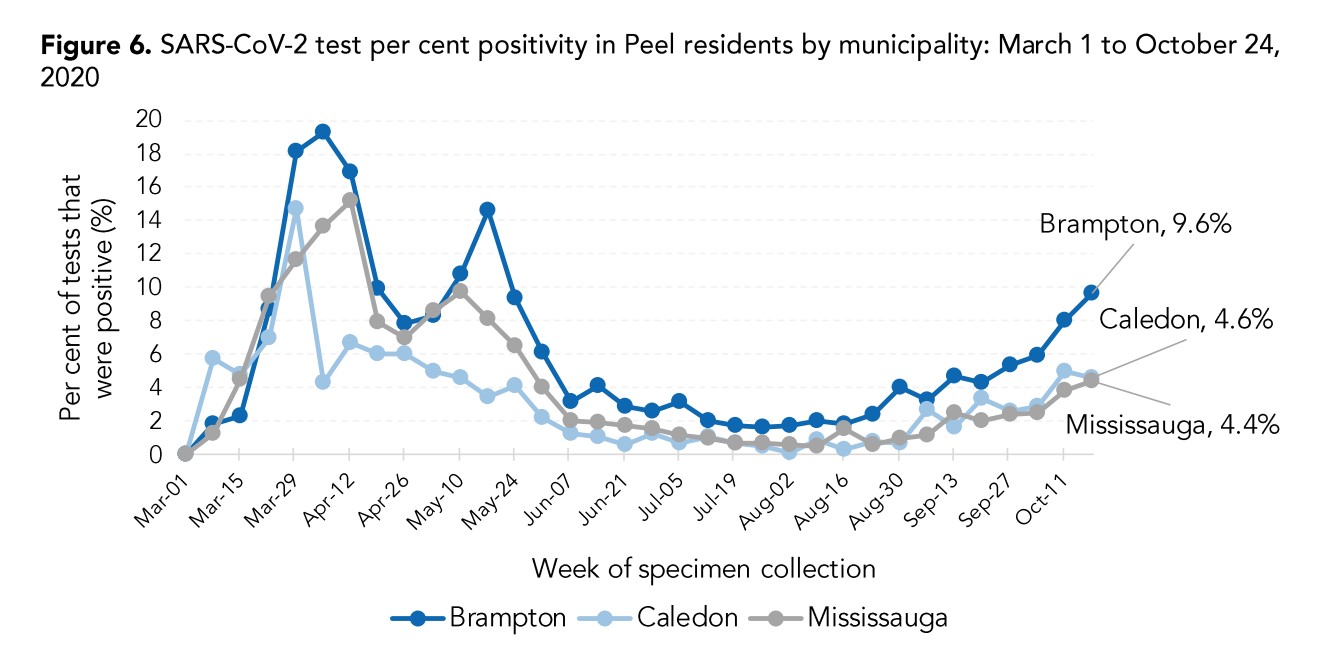
Peel ends October with daily COVID-19 cases hitting new highs
Despite public health measures intended to curb the spread of COVID-19 in Ontario's hotspots, the number of cases in Peel has climbed steeply over the last month, surging to the highest levels yet.
Peel recorded 282 cases on October 30 (the highest number reported out by the Region; on October 25 Health Minister Christine Elliott reported 289 cases in Peel – the Region and Province have had reporting discrepancies over the past few weeks). On October 31, Peel had 238 cases according to provincial data, capping off the weekend with 269 cases on November 1.
The daily average of new COVID-19 cases in Peel increased 33 percent, from 121 the week of October 4, to 161 the week of October 18.

COVID-19 case numbers in Peel have spiked over the last month to the highest seen during the pandemic.
The upward trend could signal to the Province that enhanced restrictions put in place last month ought to be extended in Peel. Premier Doug Ford has promised an update this week regarding the possible extension or end to modified Stage 2 restrictions when the 28-day period expires on November 6.
During a press conference Monday in Mississauga, Ford did not comment on whether Peel, Toronto and Ottawa – all subject to the targeted public health intervention last month – could see a loosening of restrictions, stating he would follow the advice of provincial health officials.
Business owners and some industry advocacy groups have been calling for the restrictions to be lifted, while others, including parent-groups and teachers’ unions, have said current safety measures inside schools do not go far enough.
“We have to create a happy balance,” Ford said at a press conference where provincial officials announced enhanced measures to protect long-term care homes.
Mississauga Mayor Bonnie Crombie, also in attendance, said she hopes a loosening of restrictions can come soon, but only “when it’s safe to do so.”

Mississauga Mayor Bonnie Crombie during Monday's press conference said she hopes closed businesses in her city will be able to reopen soon.
While Brampton has been the main driver of Peel’s rising COVID-19 cases, Mississauga has also begun to see an upward trend in recent weeks. In the final week of October, the city recorded 311 new cases of COVID-19, up from 285 the first week of the month.
The current modified Stage 2 restrictions target bars, restaurants, gyms and other settings identified as high-risk for the spread of infection. In the two weeks before October 29, a total of 2,341 COVID-19 cases were reported in Peel, according to the Region’s latest Public Health Surveillance report issued on Friday.
About 64 percent of those cases have been traced to exposure within a household or close-contact setting and 31 percent were linked to community spread. The next two highest exposure settings, travel and workplace outbreaks, accounted for a combined 3.2 percent of all cases.
Meanwhile, in neighbouring York Region, a wedding and four days of related events in Vaughan has led to a total of 49 COVID-19 cases, 35 of which are connected to Peel residents.
Region of Peel COVID-19 case data
-
October 4 to October 10 = 849 cases
-
-
Brampton: 527
-
Mississauga: 285
-
Caledon: 37
-
-
Peel daily average average: 121 cases per day
-
-
October 11 to October 17 = 959 cases
-
-
Brampton: 582
-
Mississauga: 333
-
Caledon: 38
-
-
Peel daily average average: 137 cases per day
-
-
October 18 to October 24 = 1,133 cases
-
-
Brampton: 789
-
Mississauga: 311
-
Caledon: 32
-
-
Peel daily average average: 161 cases per day
-
On October 31 and November 1, Health Minister Christine Elliott said the province conducted 37,100 and 27,900 tests respectively, well below her own daily target of 50,000.
With case numbers rising, Peel has continued to fall short of per capita testing levels required to effectively contain viral spread.
As reported by The Pointer, Peel Region and Toronto were conducting a comparable number of tests as of last week, but neither jurisdiction came close to its per capita target under the Province’s goal of 50,000 tests a day in Ontario.
An average of about 2,745 COVID-19 tests were completed daily in Peel between October 19 and 25, per data provided by Ontario Health. Toronto, with about double Peel’s population, completed just over twice as many tests, with an average of 5,889 a day in the same period.
To reach its share of the provincial target, based on per capita figures and a population of 1.5 million, Peel must conduct 5,172 tests daily, and Toronto, based on a population of 3 million, has to complete 10,344 tests (these figures are based on an Ontario population of 14.5 million).
The Peel health surveillance report also signals other indicators are trending in the wrong direction, with the last week of October showing a further lag in response time for reporting positive results to public health, compared to the previous week.
Peel’s acute care bed capacity was at 92 percent between October 20 and 26 (when this figure hits 90 percent it “requires attention”) whereas intensive care beds and those with ventilators were meeting availability targets, the report said, though the ICU capacity of 86 percent was nearing the same 90 percent threshold.
At Trillium Health Partners’ hospitals, five patients were receiving critical care of the total 21 COVID-19 patients in the system as of Monday. Brampton Civic Hospital has recently seen a comparable caseload, with six patients in ICU out of 27 patients being treated for COVID-19, said Dr. Naveed Mohammad, president of the William Osler Health System, in an October 28 press conference.
The region’s COVID-19 test positivity rate had also increased to 5.4 percent for the week ending October 24, up from 3.6 percent at the beginning of the month. The latest regional positivity data will be released at the end of the week.
Of the three municipalities, Brampton’s positivity rate was the highest at 9.6 percent for the week ending October 24 as reported by The Pointer, more than double Mississauga’s 4.4 percent rate and Toronto’s which sat at 4.6 percent over the same period.

Some jurisdictions in the province, including Peel, are using a goal of three-percent test positivity. Anything above this indicates “increasing infection rates or insufficient testing rates,” according to the Region’s last health surveillance report.
In an online article published by CP24 November 1, Peel’s Medical Officer of Health Dr. Lawrence Loh said he did not think the Region was “in a position to return to Stage 3.”
Dr. Loh also told the CBC on Saturday that Peel Region is in the “midst” of a second wave. The statement came only five days after Peel’s top public health official first declared the region was in a second wave, despite data indicating the second wave began weeks ago when the region began to see cases rise between August and September.
He was not available for comment Monday.
Email: [email protected]
Twitter: @LaVjosa
COVID-19 is impacting all Canadians. At a time when vital public information is needed by everyone, The Pointer has taken down our paywall on all stories relating to the pandemic and those of public interest to ensure every resident of Brampton and Mississauga has access to the facts. For those who are able, we encourage you to consider a subscription. This will help us report on important public interest issues the community needs to know about now more than ever. You can register for a 30-day free trial HERE. Thereafter, The Pointer will charge $10 a month and you can cancel any time right on the website. Thank you.
Submit a correction about this story


